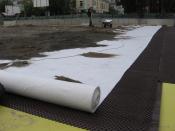Search
Login
Recommended
Cellar in the garage, how to dig a cellar with your own hands. We make a cellar in the garage in stages
Since the owners of private garages strive to exploit the occupied territory with maximum benefit, the construction of cellars in the garage is a common thing. Although today in each apartment its competitor, a refrigerator, is working very successfully, the cellar remains in demand and is very useful. The cellar is the ideal place to store part of the ubiquitously harvested vegetables - where can you store tubs with pickles and tomatoes, potatoes and carrots? The need for information on how to make a cellar in the garage with your own hands arises very often.
Content
- Where to start construction
- Types of Cellars
- How to make a cellar in a garage - consider phased work video
- We select materials
- We build the foundation
- Masonry walls
- We build a ceiling
- Waterproofing works video
- How to make floors
- We warm the cellar
- Ventilation video
Where to start construction

First, remember that the recommended size of the cellar in the garage is: depth from 1.7 to 1.9 m, width - from 2 to 2.5 m. Even if there is an area you should not make the cellar very wide.
Next, we determine the type of room and draw up its plan. Making a competent drawing is a mandatory step, it will allow the calculation of materials. It is recommended to build a cellar with a margin of at least 0.5 m from the walls - this is how much space will be required for installing side waterproofing, the surface of a strip foundation can be used as a wall.
When using the second option, it will be possible to obtain savings, but it is necessary to observe the condition: the floor level should be higher by 0.3 m from the level of the strip foundation. This option of the project can be resorted to only if there is confidence that working with the base of the garage will not be able to harm the structure.
The work plan must include waterproofing the premises and the arrangement of its ventilation system. Although the issue of constructing a cellar in a garage can be solved in different ways, the most practical thing will still be the entrance equipment through the hatch and the use of an ordinary staircase. If the garage area allows, you can resort to the construction of concrete steps.
Types of Cellars

According to the principle of the location of the cellar can be divided into two types: standing separately or under the premises. Since the planned storage will be located on the territory of the garage, its appearance will be determined by depth. In the garage you can build a semi-deep pit for storing vegetables. It is being built according to the same principle as the observation pit, although some craftsmen manage to very successfully adapt a tank dug into the ground for these purposes.
Half-deep pit can be built even in humid areas, as its depth is usually from 0.7 to 1 m. The walls of the pit are poured from cinder concrete or concrete or laid out from brick. For waterproofing, gluing and coating materials or clay locks are used.
Building is more popular. completely buried the cellar. A depth of 1.5 to 3 m is considered rational. The calculation of the parameters of such a structure is made taking into account data on the groundwater level. It is advisable that the bottom of the cellar is 0.5 m above this level.
How to make a cellar in a garage - consider phased work
The most important requirements for design and construction work include the following:
- To start work, being confident in the possibility of digging a hole from 2 to 3 m deep - in urban conditions at this depth there are numerous engineering communications.
- A mandatory point will be the study of groundwater levels.
It should be remembered that the construction in the finished garage of a buried cellar is not a very competent solution. If the issue is not subject to discussion, then it will be necessary to provide protective measures against washing with groundwater. It should be clarified that no modern methods can solve the problem of eliminating the source of flooding of the finished basement, it is best to prevent the situation before starting construction by constructing a circular drainage system.
Material Selection Rules
For the construction of the walls of the cellar, you can use different building materials, the reason for the preference of any of them is often only the cost, especially if there is a desire to build a cellar at low cost. For the quick construction of the walls of the cellar, you can use reinforced concrete slabs, but you will have to pay a considerable amount for the purchase of materials. The prices for monolithic concrete and wild stone are more affordable. If red brick is used, then it is only qualitatively burnt. Experts advise against using cinderblock materials or silicate bricks during construction.
For pouring the foundation, concrete M 100 or concrete prepared according to a standard recipe is used: cement grade 400, sand, gravel. Cement-sand mortar is also used for screeding and plastering the inner surface of the walls.
To assemble the formwork, it is recommended to use solid boards. As a budget option for waterproofing, you can use laying on the molten resin of several layers of roofing material.
How to make a foundation
Foundation construction begins with digging a foundation pit. Having reached the planned depth, the bottom is leveled and compacted, lined with a layer of crushed stone or brick fight 3 cm, poured with a layer of concrete, the total thickness of the layer is about 7-8 cm.
When the concrete completely hardens, they perform waterproofing work: they lay two layers of roofing material, gluing them with molten resin. A prerequisite is that at the edges of the waterproofing material should go 10-15 cm beyond the borders of the wall. Next, formwork is installed and poured with mortar.
To secure their construction, a drainage system is built with a high level of groundwater.
Masonry walls

Depending on what material will be used, choose the masonry method. For example, for a brick, it is best to choose the simplest masonry option. The main thing in its implementation is the observance of the verticality of the walls. The seams between the bricks are rubbed thoroughly, both outside and inside. Brick walls in the cellar are recommended to be painted with lime.

The construction of monolithic concrete walls is notable for its simplicity, however, the process somewhat complicates the need for the construction of formwork. They assemble it in the following way: shields are knocked down from strong even boards for each wall, metal poles are driven along the perimeter of the foundation, formwork is fastened to them, concrete is prepared and poured.
How to equip a cellar ceiling in a garage

To simplify the assembly process of the ceiling, reinforced concrete slabs are used. A hole is made in the plate for the hatch, the level of its installation is determined on the basement of the building. The installed plate is coated with resin, insulated with glass wool or cement-sawdust mixture. The optimum thickness of the insulation layer is from 15 to 20 cm. To finish the surface, use a lining or slate, in case of installing an additional insulation layer, the ceiling surface is plastered.
How is waterproofing a cellar in a garage
In order to make the cellar operation comfortable, a number of waterproofing works will be required. You can use modern materials for this, but you can resort to traditional, having a lower cost. The minimum cost will entail the use of bitumen lubricant. It is applied in two layers, a layer of roofing material is placed between them. On top of the waterproofing structure sprinkled with coarse sand.
For the treatment of internal walls, it is better to use mixtures for the so-called penetrating waterproofing. Their uniqueness is that without creating a film on the surface, they penetrate the structure of the material and turn the wall into a monolithic structure. The undeniable advantage of penetrating insulation is that it cannot be damaged, and its service life is equal to the service life of the walls themselves. Penetrating waterproofing can be used for external and internal surfaces, and these surfaces should not be dry, they are even recommended to moisten before applying the mixture.

Apply the mixture - diluting it with water, using a wide brush. The thickness of the applied layer is up to 2 mm. Manufacturers of penetrating waterproofing argue that it is able to penetrate through the capillaries of wall material to a depth of 0.9 m, creating insoluble crystalline formations in it.

Crystals fill all voids in concrete and eliminate the path of moisture, while the walls do not lose their vapor permeability.
Processing concrete will significantly increase its technical characteristics, in particular - it will be able to resist water pressure under a pressure of about 20 atmospheres. A positive point can be considered the simplicity of applying waterproofing, the possibility of its implementation without any additional equipment, moreover, the owners of the garage can do the job themselves.
How to make garage cellar floors
The most practical material for its manufacture is considered reinforced concrete. The leveled surface of the floor is covered with a layer of rubble and sand (15 cm + 5 cm), well tamped. To speed up the construction process, you can use a reinforced concrete slab as a floor.

You will have to make a little more effort to create a reinforced concrete surface with your own hands: by installing reinforcing bars, the foundation is created for laying the reinforcing mesh, then the mesh itself is laid, filled with at least a four-centimeter layer of concrete.
How to insulate a cellar in a garage
Expanded polystyrene can be used as insulation for basement walls; it should be installed on the outside of the walls. Among its advantages, builders note: a high level of water resistance, resistance to mold and fungi, long service life.

Most often, PSB-S-25 material with a thickness of 50 mm is used to isolate the walls of the cellar. Installation of insulation on both surfaces of the wall will allow you to have a stable temperature in the room. When only the inner surface of the walls is insulated, there is a risk of subsidence at the joints of the condensate.
Sawdust can be used to insulate the concrete floor. They are laid in a layer up to 40 cm, carefully tamped. Next, lay a layer of roofing material and perform a cement screed. Further processing of the cured surface with bitumen will also be required.

It is recommended to pay special attention to the insulation of the ceiling - it is on its surface that condensate will precipitate when cold air enters the basement. If a concrete slab is used as a basement floor in the garage, then a false ceiling will most likely be required. It can be constructed as follows: in the walls of the cellar, at a distance of about 15 cm from the floor slab, pipes are fastened, a fence net is constructed from reinforcement rods. The design is painted with waterproof paint. The space between the floor panel and the reinforcement grille is filled with insulation - mineral wool materials can be used.
Cellar ventilation in the garage

The high-quality storage of fruits and vegetables in the basement depends on how well the supply of fresh air to the room is organized and what level of humidity is maintained in it.

There are two options for arranging the ventilation system, the first one is simple and inexpensive, this is natural ventilation, which involves the installation of supply and exhaust pipes so that air can circulate freely. An exhaust pipe is mounted near the ceiling, the supply air is positioned so that its edge is 10 cm from the basement floor, the second is half a meter above the roof. The second end of the supply pipe is led out and covered with a net. It is recommended to place covers over both pipes.

A more expensive and complex method is forced, for its arrangement it will be necessary to install a fan in the exhaust pipe. When it is turned on, stagnant air will be expelled, and the cellar will be filled with fresh air.
The optimal cost and effectiveness is considered a combined installation of forced and natural ventilation. The use of forced ventilation will be needed in the summer - when the difference in street temperature and inside the cellar reaches a minimum.
At the final stage of construction of the cellar and its preparation for operation, a manhole cover is installed, a ladder is installed. By the beginning of the harvesting season, racks with shelves are installed in the cellar. Before filling the basement, it should be dried and cleaned of pathogens. To do this, it is enough to burn tableted alcohol in the room (10 tablets).





